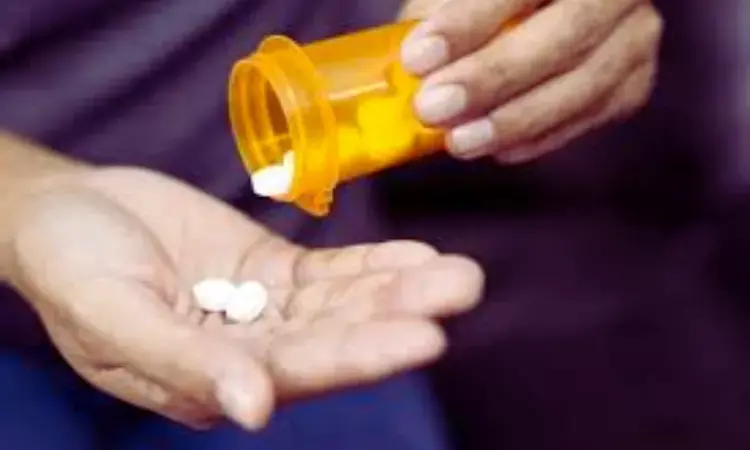- Home
- Medical news & Guidelines
- Anesthesiology
- Cardiology and CTVS
- Critical Care
- Dentistry
- Dermatology
- Diabetes and Endocrinology
- ENT
- Gastroenterology
- Medicine
- Nephrology
- Neurology
- Obstretics-Gynaecology
- Oncology
- Ophthalmology
- Orthopaedics
- Pediatrics-Neonatology
- Psychiatry
- Pulmonology
- Radiology
- Surgery
- Urology
- Laboratory Medicine
- Diet
- Nursing
- Paramedical
- Physiotherapy
- Health news
- Fact Check
- Bone Health Fact Check
- Brain Health Fact Check
- Cancer Related Fact Check
- Child Care Fact Check
- Dental and oral health fact check
- Diabetes and metabolic health fact check
- Diet and Nutrition Fact Check
- Eye and ENT Care Fact Check
- Fitness fact check
- Gut health fact check
- Heart health fact check
- Kidney health fact check
- Medical education fact check
- Men's health fact check
- Respiratory fact check
- Skin and hair care fact check
- Vaccine and Immunization fact check
- Women's health fact check
- AYUSH
- State News
- Andaman and Nicobar Islands
- Andhra Pradesh
- Arunachal Pradesh
- Assam
- Bihar
- Chandigarh
- Chattisgarh
- Dadra and Nagar Haveli
- Daman and Diu
- Delhi
- Goa
- Gujarat
- Haryana
- Himachal Pradesh
- Jammu & Kashmir
- Jharkhand
- Karnataka
- Kerala
- Ladakh
- Lakshadweep
- Madhya Pradesh
- Maharashtra
- Manipur
- Meghalaya
- Mizoram
- Nagaland
- Odisha
- Puducherry
- Punjab
- Rajasthan
- Sikkim
- Tamil Nadu
- Telangana
- Tripura
- Uttar Pradesh
- Uttrakhand
- West Bengal
- Medical Education
- Industry
New Guidelines Recommend Personalized Benzodiazepine Tapering with Psychosocial Support

USA: New guidance outlines strategies for safely tapering benzodiazepine use when risks outweigh benefits. The recommendations emphasize individualized tapering plans based on patient response, the use of psychosocial interventions to ease withdrawal, and ongoing reassessment of therapy risks and benefits. Shared decision-making between clinicians and patients or care partners is strongly advised throughout the process.
The Journal of General Internal Medicine recently published a joint clinical practice guideline developed by the American Society of Addiction Medicine (ASAM) in collaboration with nine other medical societies and professional organizations. The guideline offers structured, evidence-informed recommendations for tapering benzodiazepines (BZDs) in adult patients who may be physically dependent and for whom continued use may pose greater harm than benefit.
This multi-society collaboration utilized modified GRADE methodology and clinical consensus to formulate its recommendations. The process included a comprehensive review of existing literature, supplemental searches, and a robust stakeholder feedback system.
Given the limited number of high-quality studies on BZD tapering strategies, most of the recommendations are based on clinical expertise and experience rather than randomized controlled trials. Nonetheless, the guideline provides a much-needed framework for healthcare providers navigating the complex process of benzodiazepine discontinuation, particularly in vulnerable populations.
Key Recommendations for Benzodiazepine Tapering:
• Assess ongoing risks and benefits:
Providers should continuously evaluate whether the risks of ongoing BZD use outweigh the therapeutic advantages. Tapering should be initiated when the balance shifts toward harm.
• Identify high-risk patients for frequent review:
Special consideration is needed for individuals taking opioids, those with substance use disorders, co-existing physical or mental health conditions, pregnant patients, and adults over 65.
• Engage in shared decision-making:
Treatment plans should be made collaboratively with patients and their caregivers to ensure transparency and adherence.
• Avoid abrupt discontinuation:
Sudden cessation of BZDs in physically dependent patients can lead to serious withdrawal. A gradual taper is essential.
• Outpatient vs inpatient care:
While most patients can taper in an outpatient setting, those with higher risk should be considered for inpatient or residential care.
• Tapering pace and flexibility:
Start with dose reductions of 5–10% every 2–4 weeks. For long-term users or those with complications, tapering might need to extend over months or years.
• Tailor the taper to individual response:
Adjust the taper speed as needed, and consider switching to a longer-acting BZD for smoother reductions.
• Psychosocial support:
Cognitive behavioral therapies, especially for insomnia, can ease the tapering process and reduce withdrawal symptoms.
• Manage co-occurring disorders:
Simultaneous treatment for psychiatric or physical conditions that may complicate tapering is recommended.
• Incorporate harm reduction:
Provide naloxone where needed, educate patients about risks, and connect them with relevant resources.
Despite the lack of robust controlled studies on benzodiazepine tapering, this guideline fills a critical gap by offering a structured, consensus-based approach for clinicians. It also calls for further research to strengthen the evidence base and optimize patient safety and outcomes in BZD management.
Reference:
Brunner, E., Chen, CY.A., Klein, T. et al. Joint Clinical Practice Guideline on Benzodiazepine Tapering: Considerations When Risks Outweigh Benefits. J GEN INTERN MED (2025). https://doi.org/10.1007/s11606-025-09499-2
Dr Kamal Kant Kohli-MBBS, DTCD- a chest specialist with more than 30 years of practice and a flair for writing clinical articles, Dr Kamal Kant Kohli joined Medical Dialogues as a Chief Editor of Medical News. Besides writing articles, as an editor, he proofreads and verifies all the medical content published on Medical Dialogues including those coming from journals, studies,medical conferences,guidelines etc. Email: drkohli@medicaldialogues.in. Contact no. 011-43720751


